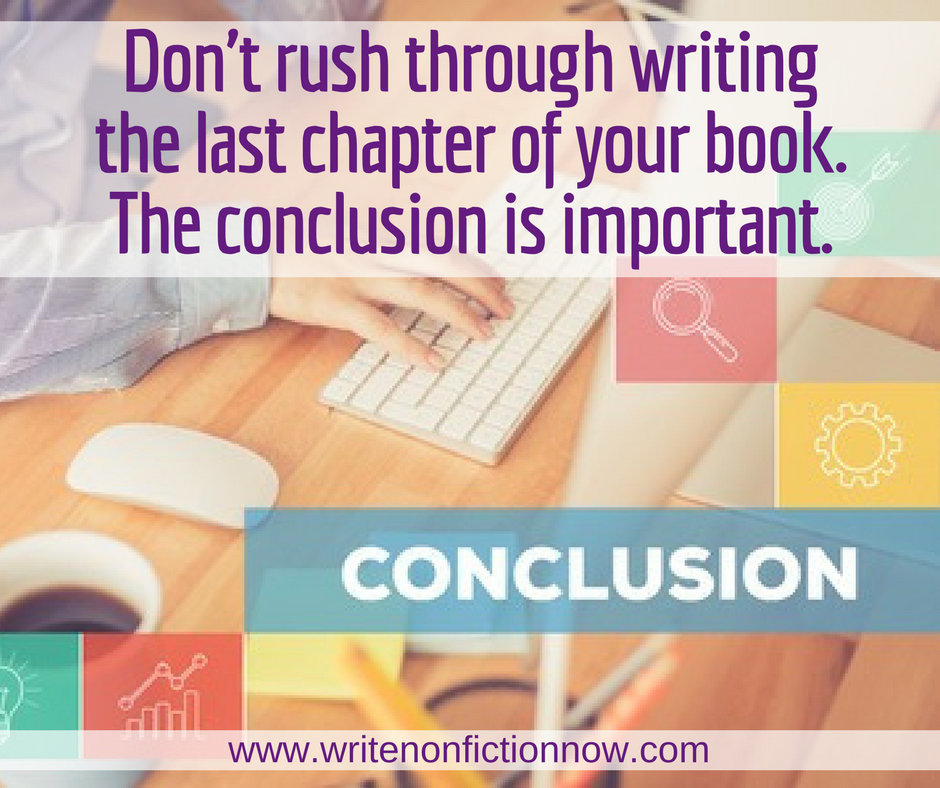Wednesday, September 27, 2017

Most nonfiction books end with a conclusion. But too may writers rush through this important last chapter in the book. In this guest post, book editor
C.K. Bush (
@theladyck) offers a variety of ways to write a conclusion for your nonfiction book and explains why you need to spend time finishing your book well.
I always say my authors “activate” in fall. They have spent their summers writing their books and then, inevitably, pop into my inbox in the first few weeks of September with freshly completed manuscripts. Their excitement to get the book off to their editor shows—but not always in a good way.
I always can tell when an author is just ready to be done writing. The final chapters get shorter and more similar in structure, and then the book ends in a conclusion that’s two pages long and sums up the book quickly before simply
ending.
Conclusions often end up short and short-changed because writers feel they have nothing left to say. In a way, they are right: the bulk of the important ideas should be included in the main body of your book. But that doesn’t mean that the last chapter needs to be one that says nothing.
The conclusion can do a lot of interesting work to tie up the reading experience for the reader. It can help them think about the bigger implications of your story, the next steps they can take, or the lessons that they can learn from what they’ve read.
If you’re stuck on how to make your conclusion reach its potential, there is some good news: conclusions don’t need to be wildly innovative to make their mark. There are some basic formulas you can follow in creating a conclusion that wrap up your work in a meaningful way.
The conclusion can do a lot of interesting work to tie up the reading experience for the reader. Click To Tweet
Conclusion #1: The “Where are They Now” Conclusion
In a ‘where are they now’ conclusion, the author talks about their or their subject’s current life after having undergone the journey discussed in the book. This type of conclusion works best with memoir or autobiography, but it can also work for biography or a kind of narrative involving multiple characters going through a concrete event.
If you use this type of conclusion, be careful not to just include a rote summary of what everyone’s doing; dive in to how the events in the book link up to your or the subject’s present-day experience.
Conclusion #2: The “Why Should We Care” Conclusion
This type of conclusion is the most common one I see, and that’s because it’s so effective. This kind of conclusion steps out from the close focus of the book to explore the bigger picture into which the book fits. In a journalistic story, it’s a chance to say how the stories in a book fit in to a larger trend and why that trend is important. In a history or other more discursive book, the conclusion is a place to explain how the topic discussed in the book illuminates new information and unveils new ways of looking at a particular subject.
The important thing to keep in mind with this kind of conclusion is that you want to avoid being repetitive, as you may have discussed the “so what” of your argument in your introduction or in scattered places throughout the book. If you find yourself in this position, my general advice is to examine the implications of the book more fully in the conclusion and change earlier discussion of those implications to be more succinct.
Conclusion #3: The “What Do We Do Now?” Conclusion
A “what do we do now” conclusion works well in how-to or advice books. If you are writing a book about getting involved in politics as a young person, for instance, you could write a conclusion that gives distilled real-world tips on how someone could get involved. If you are writing a book on how to do something that follows a standard process (say, writing nonfiction books) then the conclusion could be the final step in the process, or getting started again after going through the process once.
Conclusion #4: The “Artsy Cliffhanger” Conclusion
In memoirs, journalistic narratives, or true-crime books, there might not be a clear, solid ending to a narrative. The mystery hasn’t been solved; you (the memoirist) conquered your demons a little but not all the way; the international crisis in Africa you witnessed is still ongoing. In these cases, it could be interesting to take a more artistic approach and end the book with a story that shows there is not yet a resolution to the story.
This can be a moving ending, but take care to add in extra “so what” narration if it is not immediately clear why you are not adding in a more resolute conclusion to the book.
You owe it to your readers to keep them engaged until the very end of the book.Click To Tweet
Conclusion #5: The Combo Method
As you might guess, sometimes just following one of these conclusion approaches won’t quite be enough for your book. In these cases, experiment with combining two or more approaches. A “where are they now” structure can be the story that makes up your “artsy cliffhanger” conclusion; a “why should we care” conclusion can take the form of a “what do we do now” ending. Above all, you should think about your readers: what would they want or need before ending the book? The conclusion is really for them.
As I’ve said before on this blog, there is no one-size-fits-all approach to writing any part of a book; what type of conclusion you have can vary by the kind of book you are writing and what you want to ultimately say. But what does matter is that you have one in the first place. Like I’ve said with
introductions, take care to put together a good conclusion—you owe it to your readers to keep them engaged until the very end of the book.
About the Author
 C.K. Bush
C.K. Bush is a nonfiction editor and writer. She lives in New York City.
Photo copyright: garagestock / 123RF Stock PhotoThe post
Writing the Perfect Conclusion for your Nonfiction Book appeared first on
Write Nonfiction NOW!.
Nina Amir, the bestselling author of How to Blog a Book and The Author Training Manual, is a speaker, a blogger, and an author, book, blog-to-book, and high-performance coach. Known as the Inspiration to Creation Coach, she helps creative people combine their passion and purpose so they move from idea to inspired action and positively and meaningfully impact the world as writers, bloggers, authorpreneurs, and blogpreneurs. Some of Nina’s clients have sold 300,000+ copies of their books, landed deals with major publishing houses and created thriving businesses around their books. She is the founder of National Nonfiction Writing Month, National Book Blogging Month, and the Nonfiction Writers’ University. As a hybrid author she has published 19 books and had as many as four books on the Amazon Top 100 list at the same time. Her most recent book is called Creative Visualization for Writers, and tomorrow her 19th book will be released, The Write Nonfiction NOW! Guide to Creativity and Flow. Find all her books at booksbyninaamir.com or find out more about her at ninaamir.com.